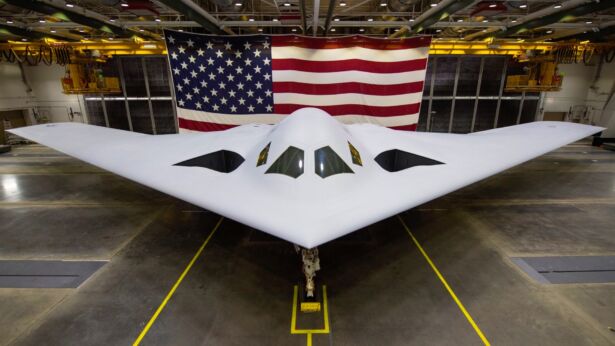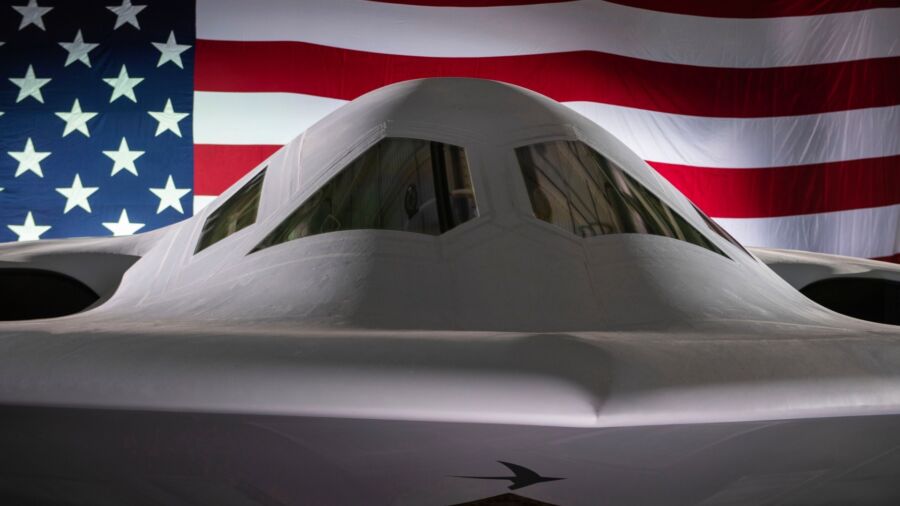The U.S. Air Force (USAF) released two pictures of America’s newest nuclear-capable stealth bomber during the 2023 Air and Space Forces Association Warfare Symposium in Colorado on Tuesday.
The B-21 Raider first debuted in early December during a tightly controlled ceremony in California. The next-generation aircraft has been in secret development for years and is the United States’ first new stealth bomber in more than three decades.
The latest model is part of the Pentagon’s efforts to modernize all three legs of its nuclear triad, which includes silo-launched nuclear ballistic missiles and submarine-launched warheads, as it shifts from the counterterrorism campaigns of recent decades to meet China’s rapid military modernization.
Gen. Thomas A. Bussier, commander of the USAF Global Strike Command, called the B-21 during Tuesday’s event the “future backbone of the bomber fleet,” adding that the military branch will have 100 of the aircraft, at a minimum, at their disposal by the mid-2020s.
The USAFs long-term bomber force structure plan is to have at least 220 of the aircraft and replace older models, the B-1 Lancer and B-2 Spirit bombers.
“The technologies that are integrated and the open architecture system will provide any potential capabilities to advance, modernize and keep that weapon system on the leading edge of a threat in the future,” Bussiere said.

At Tuesday’s event, USAF Secretary Frank Kendall emphasized the need to “modernize and reshape” the aerospace military agency in order to “confront China and other emerging powers.”
“We are united in our commitment to modernizing the Air and Space Forces and in achieving the transformation we must have to be competitive with our pacing challenge—China, China, China,” Kendall said during his 24-minute address.
China is on track to have 1,500 nuclear weapons by 2035, and its gains in hypersonics, cyber warfare, and space capabilities present “the most consequential and systemic challenge to U.S. national security and the free and open international system,” the Pentagon said in its annual China report last year.
Meanwhile, Bussiere also mentioned that the B-52 Stratofortress—which is the oldest model of all bombers—will be significantly upgraded over the coming years to help keep the aircraft operational until “at least 2050,” further noting that the aircraft “will be very different.”
“We’re updating everything—new radar, engines, upgraded communications and datalink capabilities,” Bussiere said, expanding by stating the upgraded B-52J will be more easily sustained, maintained, and “adaptable to future threats.”

Classified Program
Although almost every aspect of the B-21 program has been classified and not much information has been made public, the bomber is “extremely advanced” compared to similar models currently in service.
Kathy Warden, chief executive of Northrop Grumman—which is the company building the bomber—said that while the B-21 may resemble the B-2, once you get inside, the similarities stop.
“The way it operates internally is extremely advanced compared to the B-2 because the technology has evolved so much in terms of the computing capability that we can now embed in the software of the B-21,” Warden said.
The B-21, which takes its name from the 1942 Doolittle Raid over Tokyo, will be slightly smaller than the B-2 to increase its range, Warden said, adding that Northrop Grumman has used advanced computing to test the bomber’s performance using a digital twin, a virtual replica of the one unveiled in December.
The actual cost of the B-21 is unknown, but the USAF projected in 2010 that each bomber would cost an average of $550 million, or roughly $750 million today when adjusted for inflation.
The Associated Press contributed to this report.

